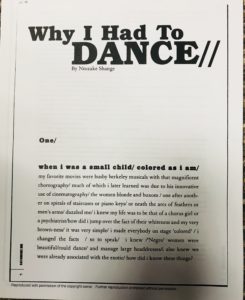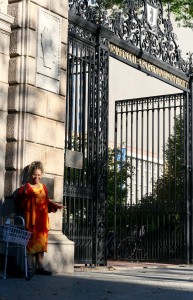
Archive Object: The original first page for “Why I Had to Dance” from Black Renaissance. Note how the letters seem to move. What is the effect of having the first line in boldface?
ASSIGNMENTS
- Ntozake Shange, selections from A Daughter’s Geography (handout)
- —– “getting to where I haveta be / the nature of collaboration in recent works” “why I had to dance,” “movement/ melody/ muscle/ meaning/ mcintyre,” “a celebration of black survival/ black dance america/ Brooklyn academy of music/ April 21-24, 1983” in Lost in Language and Sound
- Selections from Jessica Hagedorn, Beauty and Danger. Pay particular attention to the introduction, either of the two “Autobiography” poems, “Canto De Nada” (16), “Pearl” (28) and “Something About You” (73).
- “Her Pen is a Machete: The Art of Ntozake Shange“(11 mins) and “A Conversation with Ntozake Shange and Dianne McIntyre” (1 hour) from “The Worlds of Ntozake Shange.” http://bit.ly/S-FZake
- Clips from Busby Berkeley‘s Wonderbar (in class)
Today is the beginning of a twofold journey of (1) learning to read Ntozake Shange’s work and (2) learning more about the artistic and political friendships that shape her work. We will start with talking about movement. In a 2010 interview with Shange, critic Alexis Pate points to the many levels of Shange’s work: “It approaches you on multiple levels. Idea, language, music, movement, memory, action.” (Black Renaissance 10.2/3 (Summer 2010). Shange herself told previous classes that “physicality” is at the basis of her art, so we need to have some conversation about what that means.
For 1, I assigned for today some videos that hopefully give you some tips on how to read the printed page as performance along with the choreoessays from Lost in Language and Sound; or how I found my way to the arts: essays (LLS) that to me seemed most clearly to speak to the role of dance in her life and art )most particularly “Why I Had to Dance”) What does it mean to think capaciously about “movement”? Towards the end of “Why I Had to Dance,” Shange says, “It is possible to start a phrase with a word and end with a gesture.” How do gesture/movement and the spoken text work together?
For 2, I gave you selections from Filipina writer and performance artist
Jessica Hagedorn who was an early friend
and collaborator.
What do you learn about San Francisco in the 1970s from her introduction? How does it gibe with Shange’s description of that era in the video? Pay particular attention to the two “Autobiography” poems, “Canto De Nada” (16), “Pearl” (28) and “Something About You” (73). You’ll find both Hagedorn’s and Shange’s work rich with musical, literary and real world
allusion.
How would you characterize their use of description and music? How do they use paratext?It would interrupt your reading experience to look up all of the allusions, but you should get into the habit of investigating some of them. In an earlier reading, I decided to look up Busby Berkeley, because I had a vague childhood memory of the trailers from his musicals.
The Busby Berkeley dance numbers I remember were entrancing and overwhelming. I don’t know if as a kid (by then his time had passed–just how old do you think I am?) I noticed how really
heteronormative (a key element of musicals themselves) the musicals were. So too, I probably didn’t notice how much of the glamour was linked to classic notions of femininity and to the angelic glow that Richard Dyer sees as constitutive of cinematic whiteness. Now that impression is so overwhelming, I just can’t shake it.
The first question for me then became: how did Shange incorporate into a diasporic consciousness something that seems to exclude the possibility of color: in her own words, “how did i jump over the fact of their whiteness and my very brown-ness” (LLS 51)? How does she move from Hollywood spectacle/Euro-“American” tradition to something that is more diasporic?
In Dianne McIntyre’s choreography of the essay (which I’m sorry I couldn’t acquire for you), the dancers move about using white cloth–the motion mimicking the flowing costumes of a Berkeley number (and perhaps that
black girls’ childhood game of using sheets and towels to pretend to have flowing white hair.) McIntyre’s dancers move through Berkeley-inspired movements to the more intimate movements of home and family, Shange’s parents dancing, the dances of home and community. If Berkeley plays on a
Manichean contrast of white/black, Shange shows the diaspora as a space whose dynamism merges things that superficially seem contradictory or oppositional:
my mother was not only blonde at that time/ but she could dance/ and carried herself with aplomb and a flirtatiousness that was at the core of the berkeley chorus girl.
The beauty, poise and femininity the Berkeley chorus claims as an attribute of whiteness becomes something Shange can claim through a vision of her mother who is both “black” and blonde and through parents who travel throughout the diaspora to supply the sounds and movement that become the grounds for a black/diasporic aesthetic.
Looking at the Busby Berkeley routines though Shange’s essays, I see power and virtuosity, which his dancers convey through order and precision. The individual dancer’s prowess is amplified–but also subsumed by–monumental scale, architectural sets and technical innovation. In McIntyre’s choreography, we see the same values of power and virtuosity, but this time rendered through a diversity of movement and bodies. (As you know from the video, the dancers and the choreographers meticulously research allusions in the choreoessays.) The Dancers take you through a dizzying array of black/African dance movements, from colloquial dances like the shimmy & the Charleston to the signature moves of Tina Turner and the Ikettes, to the more formal, technical artistry of Katherine Dunham, Dianne McIntyre and Alvin Ailey. Blackness and black movement is multi-racial, its dynamism coming, not from perfectly choreographed order, but from a capacious and chaotic sense of history, space and time which gives everyone a place through which to enter.
Perhaps this is what the movement does/means: it collapses the distance between the reader and the text. When watching a Berkeley routine, I sit there in awe; “Why I had to Dance,” invites you dance yourself.
ANNOUNCEMENTS:




